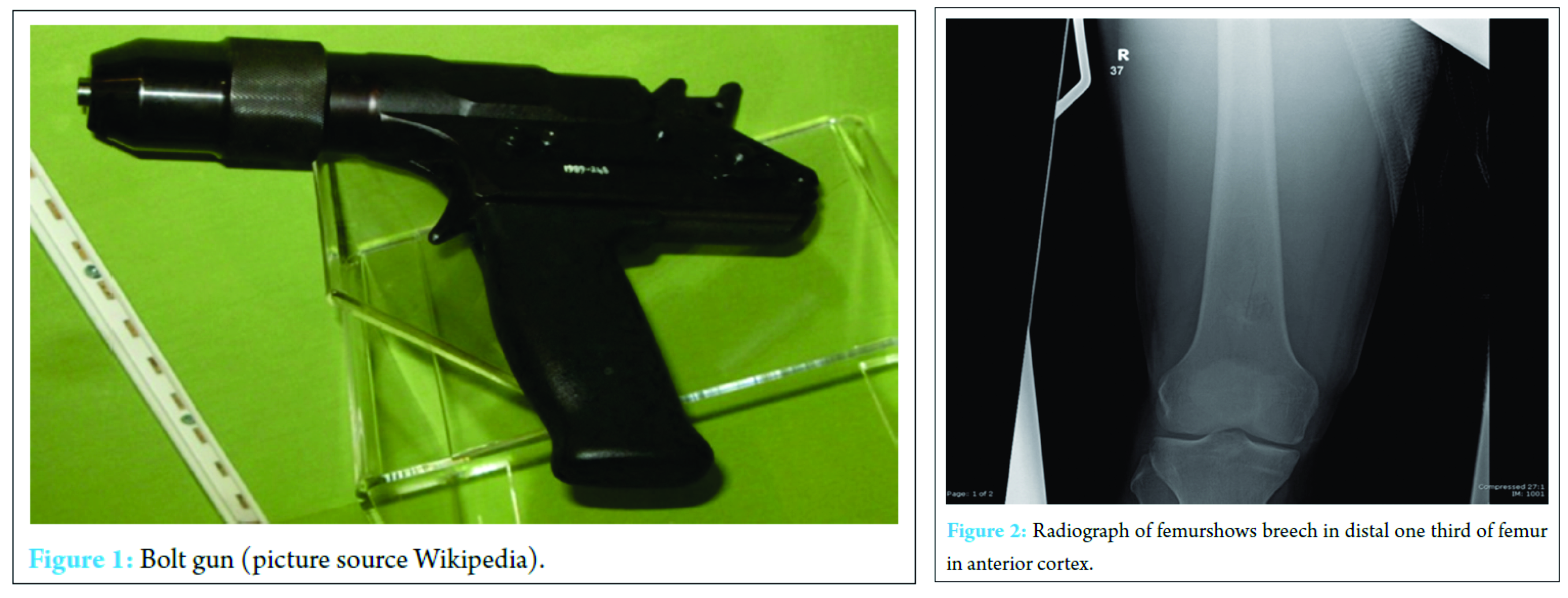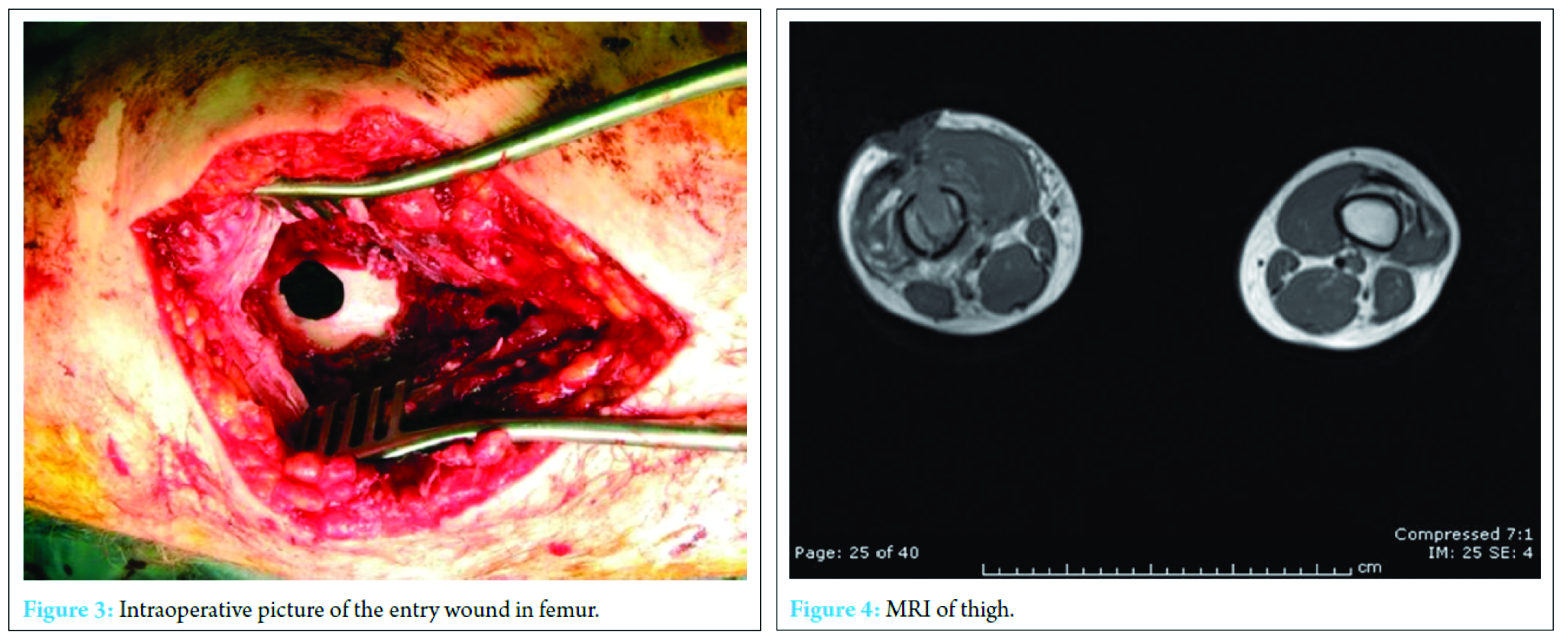[box type=”bio”] What to Learn from this Article?[/box]
The wound is primarily infected by the time the patient presents to the hospital. The wound should be explored as foreign bodies could be deeply embedded. Aggressive treatment with wound exploration, multiple wound debridement and intra venous antibiotics based on culture reports are the mainstay of treatment.
Case Report | Volume 6 | Issue 4 | JOCR September-October 2016 | Page 6-8 | Ravi Prasad Kattimani, Sanath Shetty, Humayun Mirza. DOI: 10.13107/jocr.2250-0685.544
Authors: Ravi Prasad Kattimani[1], Sanath Shetty[2], Humayun Mirza[2]
[1]Department of Trauma and Orthopedic, St. Georges Hospital, London, UK.
[2]Department of Trauma and Orthopedic, Glan Clwyd, Hospital, Rhyl, UK.
Address of Correspondence
Dr. Ravi Prasad Kattimani,
Flat 37/1, Ingelby House, Black Shaw Road – SW17 0BZ, Tooting, London.
E-mail: raviprasad.kattimani@gmail.com
Abstract
Introduction
Bolt gun or slaughterer’s guns are used in meat industry for “humane killing” of animals. Injuries caused by bolt gun are rare, reported exclusively from central European countries. We report a case of 28 year old male, who accidentally shot himself with a bolt gun to his right thigh.
Case Report
A 28-year-old male presented to our Accident and Emergency department after accidental injury to his right thigh with bolt gun. He had an entry wound measuring 2 cm in length and 1 cm in breadth over anterior aspect of lower one third of thigh at lower and sustained Grade II compound fracture of right femur shaft at distal one third. The wound was treated with multiple debridements, negative pressure wound therapy and intravenous antibiotics based on culture and sensitivity.
Conclusion
Bolt gun or slaughterer’s guns are weapons used in meat industry for slaughtering animals. Wounds inflicted by bolt guns have specific morphological feature, distinctive from wounds made by other kinds of hand firearms. Most of the time wound will be infected at presentation. Lesions caused by these weapons are likely to have a more serious character than is to be expected from the size of the entrance wound. The mainstay of treatment is liberal wound exploration, multiple debridement’s and intra venous antibiotics based on culture reports to treat infection and prevent morbidity.
Key words: Bolt gun injury, slaughterer’s gun, thigh
Introduction
Bolt guns (Fig. 1) are weapons used in meat industry for slaughtering animals. It causes immediate loss of consciousness thus causing humanization of the process [1]. Injury with bolt gun is rare. Wounds inflicted by bolt guns have specific morphological features, distinctive from wounds made by other kinds of hand firearms. Most of the time wound will be infected at presentation. Lesions caused by these weapons are likely to have a more serious character than is to be expected from the size of the entrance wound [3].
Case Report
A 28 year old male while attempting to slaughter a calf holding its head between his thighs accidentally shot himself with bolt gun to right thigh and sustained Grade II open fracture of distal one third shaft of femur (Fig. 2). He had an entry wound measuring 2 cm in length and 1 cm in breadth over anterior aspect of his right thigh (Fig. 3).

The wound was explored and debrided on the day of admission. Wound swab grew Pseudomonas, Proteus and Anaerobes. He was started on intra venous Augmentin. After five days, patient developed fever with chills and rigors. He also had purulent discharge from the wound. Inflammatory markers were raised with C reactive protein of 450. MRI (Fig. 4) confirmed there was no collection of pus in the posterior compartment of thigh. He underwent another wound exploration and debridement on fifth day of admission. Pus collection was found in the subcutaneous and sub muscular layers of right thigh. The wound was communicating with knee joint through the supra patellar pouch. Knee was washed out under arthroscopic guidance. The wound was treated with negative pressure wound therapy. He had a further wound debridement andsecondary wound closure after eleven days of injury and then discharged to home. The limb was immobilized in an above knee cast for four weeks and knee was later mobilized using a knee ranger splint.

He had three weeks of intravenous Ertepenem based on wound swab culture and sensitivity. At 12 months of follow up the wound healed with no signs of infection. He had full range of knee movements.
Discussion
Injuries caused by bolt gun are rare, reported exclusively from central European countries [3] and cases are reported about their use in homicide [6, 7] and suicide [8, 9, 10] with mortality of more than 60%. [1, 2]. The death by bolt gun is by concussive force and penetration of the bolt [1]. The propulsive force of piston in bolt gun has such strength that lesions caused by these weapons are likely to have more serious complications than are to be expected from the size of entrance wound [3]. Wounds inflicted by bolt guns have specific morphological features, distinctive from wounds made by other kinds of hand firearms [10]. Selective features of bolt gun wounds are punched out round entrance and a double pattern of smoke soiling (wide zone of carbon deposition) [5]. Contamination of wound occurs by normal skin flora, clothes, water, soil and foreign bodies. These wounds are primarily infected with mixed bacterial flora of skin at the time of presentation to the hospital [3]. The dead tissue and debris form an excellent culture medium, leading to local proliferation of microorganisms; proliferation of bacteria can be demonstrated as early as six hours after injury [4]. The wounds caused by bolt gun injury must be explored to detect any foreign bodies, and all devitalized tissue must be excised to minimize risk of infection. Torn clothing will be often left behind deep inside the wound. So, it is essential to get detailed information about the clothing at time of injury, especially hand injuries as they often appear uncovered on arrival in the emergency department [3].
Conclusion
Accidental injury with bolt gun injury is rare. Wounds inflicted by bolt guns have specific morphological features, distinctive from wounds made by other kinds of hand firearms. The wound is primarily infected at the time of presentation to the hospital. Aggressive treatment with wound exploration, multiple wound debridement and intra venous antibiotics based on culture reports are the mainstay of treatment to treat infection and prevent morbidity.
Clinical Message
For the surgeon treating bolt gun injuries it is imperative that a multiple wound debridement’s are performed and a high index of suspicious of retained foreign bodies such asskin, soil and tornclothing should be maintained.
References
1. Mosdal C. Cranio-cerebral injuries from Slaughterer’s gun. Acta Neurochir (Wien) 1985;74(1-2):31-34.
2. Gnjidic Z, Kubat M, Malenica M, Sajko T, Radic I, Rumboldt Z. Epidemiological, forensic, clinical, and imaging characteristics of head injuries acquired in the suicide attempt with captive bolt gun. Acta Neurochir (Wien) 2002;144(12):1271-1277.
3. Tordrup PJ, Kjeldsen SR. Accidental injuries from captive-bolt guns (slaughterer’s gun). Injury 1994;25(8):497-499.
4. Cooper GJ, Ryan JM. Interaction of penetrating missiles with tissues: Some common misapprehensions and implications for wound management. Br J Surg 1990;77(6):606-610.
5. Simic M, Draskovic D, Stojiljkovic G, Vukovic R, Budimlija ZM. The characteristics of head wounds inflicted by “humane killer” (captive-bolt gun) – A 15-year study. J Forensic Sci 2007;52(5):1182-1185.
6. Betz P, Pankratz H, Penning R, Eisenmenger W. Homicide with a captive bolt pistol. Am J Forensic Med Pathol 1993;14(1):54-57.
7. Caird J, Roberts G, Farrell M, Allcutt D. Self-inflicted head trauma using a captive bolt pistol: Report of three cases. Br J Neurosurg 2000;14(4):349-351.
8. Viel G, Schröder AS, Püschel K, Braun C. Planned complex suicide by penetrating captive-bolt gunshot and hanging: Case study and review of the literature. Forensic Sci Int 2009;187(1-3):e7-11.
9. Viola L, Costantinides F, Di Nunno C, Battista GM, Di Nunno N. Suicide with a butcher’s bolt. J Forensic Sci 2004;49(3):595-597.
10. Grellner W, Buhmann D, Wilske J. Suicide by double bolt gunshot wound to the head: Case report and review of the literature. Arch Kriminol 2000;205(5-6):162-168
11. Santín-Amo JM, Castro-Bouzas D, Arcos-Algaba A, Díaz-Cabanas L, Serramito-García R, Bandín-Diéguez FJ, et al. Intracranial injury caused by captive bolt gun. Neurocirugia (Astur) 2010;21(6):491-495.
| How to Cite This Article: Kattimani RP, Shetty S, Mirza H. Accidental Captive-bolt Gun Injury to the Distal Femur: A Case Report. Journal of Orthopaedic Case Reports 2016 Sep-Oct;6(4): 6-8. Available from: https://www.jocr.co.in/wp/2016/10/10/2250-0685-544-fulltext/ |
[Full Text HTML] [Full Text PDF] [XML]
[rate_this_page]
Dear Reader, We are very excited about New Features in JOCR. Please do let us know what you think by Clicking on the Sliding “Feedback Form” button on the <<< left of the page or sending a mail to us at editor.jocr@gmail.com





